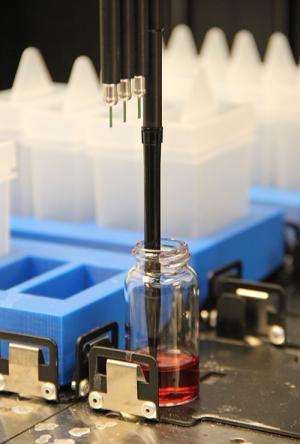Rare-earth innovation to improve nylon manufacturing

The Critical Materials Institute, a U.S. Department of Energy Innovation Hub, has created a new chemical process that makes use of the widely available rare-earth metal cerium to improve the manufacture of nylon.
The process uses a cerium-based material made into nanometer-sized particles with a palladium catalyst to produce cyclohexanone, a key ingredient in the production of nylon.
Traditional methods of producing cyclohexanone involve high temperatures and high pressure, and necessitate the use of hydrogen.
"After a lot of trials, we managed to find a reaction that works very well at room temperature and ambient pressure," said CMI scientist Igor Slowing. "That's a huge advantage cost-wise. It's more energy efficient, and requires much less hydrogen."
The discovery is a rather unique way that CMI is addressing global concerns about the supply and demand of rare-earth metals.
"The research group focused on three or four different catalytic reactions used in high production volume chemicals, including this one for producing a precursor to nylon, which as an industry has enormous applications," said Slowing.
"We are the only CMI scientists looking at catalysis, and so we are looking at this problem from a different angle. While other scientists are trying to find ways to use less of the least abundant rare-earths, we are trying to find ways to use more of the most abundant ones."
At first that seems counter-intuitive to the research mission of CMI, which includes reducing reliance on rare-earth materials.
But rare-earth metals like cerium, which is as abundant as copper, are primary products of mining for other, more valuable rare-earth elements. With minimal demand for these abundant rare earths, they are stockpiled. Finding widely marketable uses for these stock-piled materials makes the best use of all mining resources, and improves the economic feasibility of mining overall.
Slowing said the technology also has other possible applications, like the treatment of biomass.
The technology is discussed in the paper "Selective Hydrogenation of Phenol Catalyzed by Palladium on High Surface Ceria at Room Temperature and Ambient Pressure," by a team that also included Nicholas C. Nelson, Sebastian Manzano, and Aaron D. Sadow from Ames Laboratory, Steven Overbury from Oak Ridge National Laboratory, and was published in ACS Catalysis.
More information: "Selective Hydrogenation of Phenol Catalyzed by Palladium on High-Surface-Area Ceria at Room Temperature and Ambient Pressure." ACS Catal., 2015, 5, pp 2051–2061 DOI: 10.1021/cs502000j
Journal information: ACS Catalysis
Provided by Ames Laboratory


















